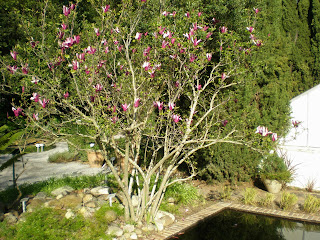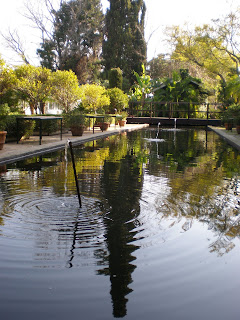
The Karoo Desert is the semi-arid part of the land in the middle of South Africa. It looks a lot like Arizona though the wild life and plants are a lot different than those found in the southwestern United States. We headed out for a four-hour drive to Beaufort West and the Karoo National Park. The drive up to Beaufort West was rather uneventful. Driving in South Africa is done on the left hand side of the rode. So traffic is reversed to how people drive in the US. Another interesting point is that when passing on two lane highways, such as the N1 we took from Stellenbosch to Beaufort West, the other driver usually pulls off into the shoulder to allow you to pass more easily. It makes it more convenient and safer than passing by use of the wrong side of the road.

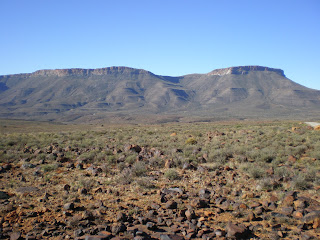


We made it to the Karoo National Park at about 2:30 pm. Which left us about three hours till the sunset and plenty of time to see animals in the park. In the park there is a 45 km loop to drive on and you can stop and take pictures at your own leisure. We say many different animals such as kudu (a sort of small antelope) zebra, baboons and ostrich. We also saw Oryx, which are large cow-moose-deer-like animals, and springboks. As the sun began to set we saw more animals in their individual flocks. It was really amazing.
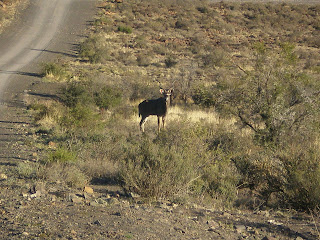






After the park we checked into our hotel in Beaufort West, which is apparently just a small truckers town. There were barely anyone around at 7:00 pm and when we ate at a local restaurant we were the only ones eating. I had a great ostrich burger followed by a shared slice of Godiva chocolate cheesecake! It was excellent! After dinner we headed back out to Karoo to see the stars. Being in a small town in the middle of the desert allows for little light pollution and excellent view of the stars. I have never seen something more beautiful in my life. Although, we couldn’t identify constellations we could clearly see the Milky Way galaxy and a few planets.
When we drove back into town we stopped at a routine stop behind traffic. What we didn’t know was that we had stopped in what is referred to a junction box, a box on the ground with a “X” through it. They are used to make sure entrances to businesses aren’t blocked by traffic. A traffic officer spotted us and flagged us down, where Edward (the driver) received a R300 fine. However, I think it is important to note the business wasn’t open and the traffic officer on duty was parked in the driveway of the business of the junction box we had “stopped” in. It was stupid. So after that fiasco we headed back to the hotel and settled into bed. We all enjoyed the use of TV and happened to catch all of The Departed with Leo DiCaprio. It was really nice to “veg-out” for an evening!
The next day we drove to Oudtshoorn, which is a town that hosts attractions such as Cango Caves, Cango Wildlife Ranch and Cango Ostrich Farm. We checked into our hostel in town where the told us that the power was out because of routine maintenance. We found out later that that it wasn’t just our hostel being affected by the outage.
We then went out to Cango Caves and explored the 250 million year old cave. The cave is about 5 km long though only 2.5 km of the cave is open to the public. They turned off the lights in the cave to demonstrate how the cave was first explored by candlelight. We also so different formations such as columns, stalactites and stalagmites as well as named formations such as the “organ pipes”, the “weeping willow”, the “devil’s head”, the “bible”, the “wedding bed” and the “champagne bottle”. It was amazing!!!





After the caves we went to the Cango Wildlife Ranch, which ended up being more expensive than we thought. It is also more like zoo than anything and we found out later that night that the crocodiles weren’t even on exhibit due to unexplained reason. So instead we headed to the Cango Ostrich Farm where we got a tour of the farm and got to ride the ostriches for less than half of what it would have cost us to see the wildlife ranch. Ostriches are some of the dumbest birds on the planet. Their brains, we learned, are smaller than their eyes. They have an extremely flexible neck that can wrap around itself and reach the ground when the bird is standing. We also learned that they are the second fastest animals in the world, after the cheetah. They can run up to 87 km/h (54 mph) for up to 3 km (1.8 miles) in a single run. They use this to escape any predators that might try to attack them in the wild. So you can imagine how exciting it was to climb on top of the bird to ride. It was exhilarating, though the farm as people run next to the bird to make sure no one falls off or gets hurt to badly after they get off the bird. It was fun and funny to ride a bird for the first time. I collected a feather, which is now serving as my ostrich driver’s license. LOL




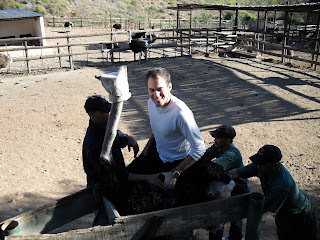

That night we hung out at our hostel for a bit and headed out to dinner. It was only until we discovered that two restaurants were open that we realized the full extent of the power outage. Everyone was with out power and I guess so was most of the Western Cape. So we had to eat our dinner by candlelight that was kind of romantic other than it was with four friends and not a singles date. I tried a platter of Karoo 4, which was a sample of different wildlife found in the Karoo. I had ostrich, kudu, springbok and crocodile. The ostrich, as I have explain in prior posts is excellent. Kudu and springbok reminded me of deer meat. They were also very good. Crocodile was salty and tasted like fish with the consistency of chicken. I really enjoyed the meal.

After dinner we enjoyed drinks by the fire at our hostel with some new friends from Oudtshoorn, Cape Town and other international travelers from England. It was a lot of fun and again we could see the billions of stars with the lack of power in the city. The next morning we drove back to Stellenbosch by the Route 62 at the recommendation of some of the locals. We stopped at a random bar half way home called “Ronnie’s Sex Shop”. It was one of those local places that you have to hit up just to say you did. It was an interesting and random bar in the Kline Karoo. I had a lot of fun in the east Western Cape and can’t wait to go back when I travel the garden route in another week!






